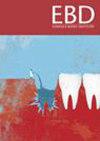Survival of the fittest: does Riva Self Cure outperform Equia Forte when used to restore mesio-occlusal cavities in atraumatic restorative technique?
Q3 Dentistry
引用次数: 0
Abstract
Double-blind (participant and outcome assessor), randomised, non-inferiority, two-arm (1:1 allocation) clinical trial. The study included children aged 4–8 years old from public schools in Tietê, Brazil, who had mesio-occlusal carious lesions, into dentine, in primary molars. The carious teeth had to be asymptomatic of pulpal involvement. The children had to be medically fit and cooperative for dental treatment within their classroom environment. Consent was gained from a parent/guardian prior to entering the study. Children with carious lesions in multiple teeth, only one tooth was included, which was selected by a random draw. Treatment on other teeth would be carried out in the nearest health centre. The primary outcome was the 2-year survival of the restorations, analysed using Kaplan–Meier survival curves and Cox regression (α = 5%). Costs for materials and professional services were recorded in Brazilian Reais (R$), converted to US dollars (US$), and analysed using Monte Carlo simulation. Of the 152 children enrolled (76 per group), 121 (79%) were evaluated at the 2-year mark. Overall, the 2-year survival rate of the restorations was 39% (EF: 45%; RSC: 32%), with no significant difference between the two groups. The total cost of restorations with RSC was lower than with EF, resulting in a cost saving of US$6.18 per restoration. After 2 years, Riva Self Cure demonstrated comparable survival rates to Equia Forte for mesio-occlusal restorations in primary molars, while being more cost-effective from a Brazilian perspective.适者生存:在无创伤修复技术中,Riva Self Cure 用于修复中-咬合龋洞的效果是否优于 Equia Forte?
设计:病例选择:双盲(参与者和结果评估者)、随机、非劣效、双臂(1:1 分配)临床试验:研究对象包括巴西蒂埃特市公立学校的 4-8 岁儿童,这些儿童的初级臼齿中层-咬合面龋坏,龋坏部位位于牙本质内。龋齿必须没有牙髓受累的症状。这些儿童必须身体健康,并能在教室环境中配合牙科治疗。参加研究前,必须征得家长/监护人的同意。多颗牙齿龋坏的儿童只包括一颗牙齿,由随机抽签决定。其他牙齿的治疗将在最近的医疗中心进行:主要结果是修复体的 2 年存活率,采用 Kaplan-Meier 生存曲线和 Cox 回归法进行分析(α = 5%)。材料和专业服务的成本以巴西雷亚尔(R$)记录,然后换算成美元(US$),并采用蒙特卡罗模拟法进行分析:在登记的 152 名儿童(每组 76 名)中,有 121 名(79%)在 2 年后接受了评估。总体而言,修复体的 2 年存活率为 39%(EF:45%;RSC:32%),两组之间没有显著差异。RSC修复体的总成本低于EF修复体,每颗修复体可节省6.18美元:2年后,Riva Self Cure与Equia Forte在初级磨牙中窝洞修复方面的存活率相当,而从巴西的角度来看,Riva Self Cure的成本效益更高。
本文章由计算机程序翻译,如有差异,请以英文原文为准。
求助全文
约1分钟内获得全文
求助全文
来源期刊

Evidence-based dentistry
Dentistry-Dentistry (all)
CiteScore
2.50
自引率
0.00%
发文量
77
期刊介绍:
Evidence-Based Dentistry delivers the best available evidence on the latest developments in oral health. We evaluate the evidence and provide guidance concerning the value of the author''s conclusions. We keep dentistry up to date with new approaches, exploring a wide range of the latest developments through an accessible expert commentary. Original papers and relevant publications are condensed into digestible summaries, drawing attention to the current methods and findings. We are a central resource for the most cutting edge and relevant issues concerning the evidence-based approach in dentistry today. Evidence-Based Dentistry is published by Springer Nature on behalf of the British Dental Association.
 求助内容:
求助内容: 应助结果提醒方式:
应助结果提醒方式:


